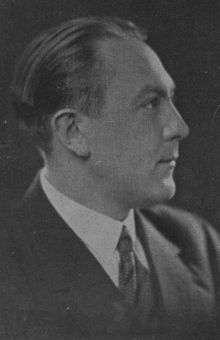Vítězslav Nezval
Vítězslav Nezval (Czech: [ˈviːcɛslaf ˈnɛzval]; 26 May 1900 – 6 April 1958) was one of the most prolific avant-garde Czech writers in the first half of the twentieth century and a co-founder of the Surrealist movement in Czechoslovakia.
Vítězslav Nezval | |
|---|---|
 Nezval in 1934. | |
| Born | 26 May 1900 Biskoupky, Habsburg Moravia, Austria-Hungary |
| Died | 6 April 1958 (aged 57) Prague, Czechoslovakia |
| Resting place | Vyšehrad Cemetery |
| Occupation | Poet |
| Nationality | Czech |
| Notable works | Manon Lescaut Sbohem a šáteček Valerie and Her Week of Wonders |
| Spouse | Františka Řepová |
| Signature | |
Biography
His father was a school teacher in the village of Biskoupky in Southern Moravia who often traveled to see art exhibitions and was also a musician who studied under the composer Leoš Janáček.[1] At age eleven, Nezval was sent to the gymnasium in Třebíč, where he learned piano and to compose music. He began writing in his teenage years while he was still interested in music. He was said to have played an accordion while studying the stars. In 1918, he was drafted into the Austrian army, but quickly sent home when he became ill. After the first World War, Nezval moved to Prague and began studying philosophy at the Charles University, but he did not receive his degree because he failed to finish his thesis. During this time, he was enchanted by the bustling literary scene that was thriving in the cafés and on the streets of Prague.
Literary work
Vítězslav Nezval was a member of the avant-garde group of artists Devětsil (literally "nine forces", the Czech name of the Butterbur plant but to a Czech-speaker an obvious reference to the nine founding members of the group). Devětsil members were the most prolific Czech artists of their generation. In 1922, the Devetsil group included, but was not limited to, Vítězslav Nezval, Jindřich Štyrský, Jaroslav Seifert, Karel Teige, and Toyen (Marie Cerminová). Also associated with the group was the later founder of the Prague Linguistic School, Roman Jakobson. Like the proletarian group before it, Devětsil looked to France for inspiration for their avant-garde literature and their Marxist political ideology originating from Russia. Though the Czechoslovakian state was newly formed after World War I, the younger generation felt there was still room for improvement and that a radical solution was necessary to gain true liberation. Most of these intellectuals had a zest for revolution and professed their allegiance to Lenin. Though their philosopher-president, Thomas Masaryk, gave them the first real socially-minded democracy, Nezval and others in his group did not accept this regime as representative of their beliefs and goals. In their writings they expressed their preference for the Marxist-internationalist consciousness of class solidarity.
The first manifesto of Devětsil urged young, progressive artists to look deeper into ordinary objects for poetic quality. Skyscrapers, airplanes, mime and poster lettering were the new arts.
Nezval was also a founding figure of Poetism, a direction within Devětsil primarily theorized by Karel Teige. His output consists of a number of poetry collections, experimental plays and novels, memoirs, essays, and translations. Along with Karel Teige, Jindřich Štyrský, and Toyen, Nezval frequently traveled to Paris where he rubbed shoulders with the French surrealists. His close friendship with André Breton and Paul Éluard was instrumental in founding The Surrealist Group of Czechoslovakia in 1934. It was one of the first surrealist groups outside France, and Nezval served as the editor of its journal Surrealismus.
In collaboration with Nezval on his book Abeceda ("alphabet"), the Devětsil dancer Milča Mayerová adopted particular poses to represent each of the letters. Nezval wrote this poem focusing on the forms, sounds, and functions of the alphabet. Teige used typography and photomontage to create lasting images of the moves which are now printed in many editions of the book.
Nezval's poem Sbohem a šáteček (Waving farewell; 1934) was set to music by the Czech composer Vítězslava Kaprálová in 1937, and was premiered in its orchestral version in 1940 by Rafael Kubelik.
See also
References
- Serafin, S., Twentieth-Century Eastern European Writers, Vol. 1 (Farmington Hills: Gale Group, 1999).
External links
| Wikimedia Commons has media related to Vítězslav Nezval. |
- Extensive biography and works (in Czech)
- Bohuš Balajka: Přehledné dějiny literatury II. Prague: Fortuna, 2005. ISBN 80-7168-781-2
- Reference – short biography
- kapralova.org